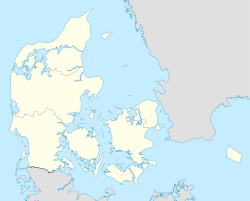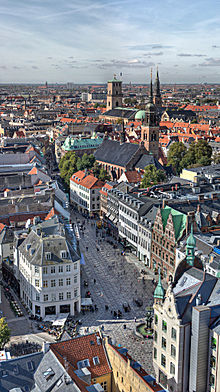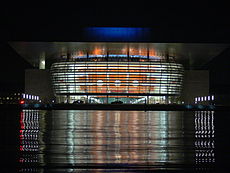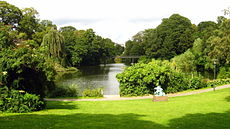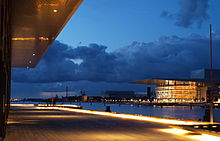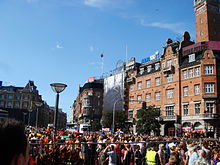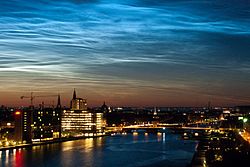- Copenhagen
-
This article is about the city in Denmark. For other uses, see Copenhagen (disambiguation).
Copenhagen
KøbenhavnClockwise: Slotsholmen island, Tivoli Gardens, City Hall Square and The Marble Church 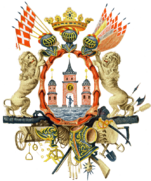
Coat of armsLocation in Denmark Coordinates: 55°40′34″N 12°34′06″E / 55.67611°N 12.56833°ECoordinates: 55°40′34″N 12°34′06″E / 55.67611°N 12.56833°E Country  Denmark
DenmarkMunicipalities[1] Region Hovedstaden First mention 11th century City Status 13th century Government – Lord Mayor Frank Jensen (S) Area – City 88.25 km2 (34.1 sq mi) – Urban 455.61 km2 (175.9 sq mi) – Metro 3,030 km2 (1,169.9 sq mi) Population (1 October 2011 for the city and metro area and 1 January 2011 for the urban area.)[2] – City 548,443 – Density 6,214.7/km2 (16,095.9/sq mi) – Urban 1,199,224 – Urban density 2,632.1/km2 (6,817.2/sq mi) – Metro 1,930,260 – Metro density 637/km2 (1,650/sq mi) Time zone CET (UTC+1) – Summer (DST) CEST (UTC+2) Website www.kk.dk/english Copenhagen (
 /ˈkoʊpənheɪɡən/ or /ˈkoʊpənhɑːɡən/; Danish: København pronounced [kʰøb̥m̩ˈhɑʊ̯ˀn] (
/ˈkoʊpənheɪɡən/ or /ˈkoʊpənhɑːɡən/; Danish: København pronounced [kʰøb̥m̩ˈhɑʊ̯ˀn] ( listen)) is the capital and largest city of Denmark, with an urban population of 1,199,224 (as of 1 January 2011[update]) and a metropolitan population of 1,930,260 (as of 1 October 2011[update]). With the completion of the transnational Øresund Bridge in 2000, Copenhagen has become the centre of the increasingly integrating Øresund Region. Within this region, Copenhagen and the Swedish city of Malmö are growing into a combined metropolitan area. Copenhagen is situated on the islands of Zealand and Amager.
listen)) is the capital and largest city of Denmark, with an urban population of 1,199,224 (as of 1 January 2011[update]) and a metropolitan population of 1,930,260 (as of 1 October 2011[update]). With the completion of the transnational Øresund Bridge in 2000, Copenhagen has become the centre of the increasingly integrating Øresund Region. Within this region, Copenhagen and the Swedish city of Malmö are growing into a combined metropolitan area. Copenhagen is situated on the islands of Zealand and Amager.First documented in the 11th century, Copenhagen became the capital of Denmark in the beginning of the 15th century. During the 17th century, under the reign of Christian IV, it became a significant regional centre.
Copenhagen is a major regional centre of culture, business, media, and science, as indicated by several international surveys and rankings (see International rankings below). Life science, information technology and shipping are important sectors, and research & development plays a major role in the city's economy. Its strategic location and excellent infrastructure, with the largest airport in Scandinavia[3] located 14 minutes by train from the city centre, have made it a regional hub and a popular location for regional headquarters[4] and conventions.
Copenhagen has repeatedly been recognized as one of the cities with the best quality of life.[5][6][7] It is also considered one of the world's most environmentally friendly cities. The water in the inner harbour is clean and safe for swimming. 36% of all citizens commute to work by bicycle. Every day, they cycle a combined 1.2 million km.[8]
Since the turn of the millennium, Copenhagen has seen a strong urban and cultural development and has been described as a boom town.[9] This is partly due to massive investments in cultural facilities as well as infrastructure and a new wave of successful designers, chefs and architects.[6] As of 2010[update], Copenhagen is ranked as the 10th most expensive city in the world according to Forbes magazine.[10]
Contents
History
Main article: History of Copenhagen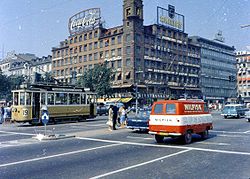 Tramcar at the City Hall Square, 1963.
Tramcar at the City Hall Square, 1963.
 1963 view from the City Hall tower looking west towards the Royal Hotel.
1963 view from the City Hall tower looking west towards the Royal Hotel.
Copenhagen's founding has traditionally been dated to Bishop Absalon's construction of a castle on the small island of Slotsholmen in 1167 where Christiansborg Palace stands today. Recent archeological finds indicate that by the 11th century, Copenhagen had already grown into a small town with a large estate, a church, a market, at least two wells and many smaller habitations spread over a fairly wide area.[11] Many historians believe that the town dates to the late Viking age, and was possibly founded by Sweyn I Forkbeard. From the middle of the 12th century it grew in importance, after coming into Absolon's possession, who fortified it in 1167, the year traditionally marking the foundation of Copenhagen. The excellent harbour encouraged Copenhagen's growth until it became an important centre of commerce. However it did not become the nation's capital until the middle of the 15th century, and the archbishop still has residence in Roskilde.
The city's origin as a harbour and a place of commerce is reflected in its name. Its original designation, from which the contemporary Danish name is derived, was Køpmannæhafn, meaning "merchants' harbour" or "buyer's haven" (cf. German "Kaufmannshafen"). The English name for the city is derived from its Low German name, Kopenhagen. The element hafnium is also named for Copenhagen, whose Latin name is Hafnia,[12] derived from the city's original name, Hafnæ ("harbour").
As the town rose in prominence, it was repeatedly attacked by the Hanseatic League. In 1254 it received its charter as a city under Bishop Jakob Erlandsen. During 1658–59 it withstood a siege by the Swedes under Charles X and successfully repelled a major assault. In 1711 the plague reduced Copenhagen's population of about 65,000 by one-third.[13]
On 2 April 1801 a British fleet under the command of Admiral Sir Hyde Parker defeated a Danish-Norwegian fleet anchored near Copenhagen. Vice-Admiral Horatio Nelson led the main attack.[14][15][16] He famously disobeyed Parker's order to withdraw, destroying many of the Dano-Norwegian ships before a truce was agreed.[14][17][18] Copenhagen is often considered to be Nelson's hardest-fought battle, surpassing even the heavy fighting at Trafalgar.[14][17][19][20][21] It was during this battle that Lord Nelson famously "put the telescope to the blind eye" in order not to see Admiral Parker's signal to cease fire.[19]
The Second Battle of Copenhagen (or the Bombardment of Copenhagen) (16 August – 5 September 1807) was from a British point of view a preemptive attack on Copenhagen, targeting the civilian population in order to seize the Dano-Norwegian fleet.[17][19][22][23] But from a Danish point of view the battle was a terror bombardment on their capital. Particularly notable was the use of incendiary Congreve rockets (containing phosphorus, which cannot be extinguished with water) that randomly hit the city. Few houses with straw roofs remained after the bombardment. The largest church, Vor frue kirke, was destroyed by the sea artillery. The battle is considered the first terror attack against a major European city in modern times by several historians.[23][24] The confiscation of the navy, would later source the term to Copenhagenize.
The British landed 30,000 men and surrounded Copenhagen.[17][19] The attack continued for the next three days, killing some 2,000 civilians and destroying most of the city.[17][19] The devastation was so great because Copenhagen relied on an old defence-line whose limited range could not reach the British ships and their longer-range artillery.[25] Not until the 1850s were the ramparts of the city opened to allow new housing to be built around The Lakes (Danish: Søerne) that bordered the old defences to the west. This dramatic increase of space was long overdue, because the old ramparts were out of date as a defence system, and because of bad sanitation in the old city. Before the opening, central Copenhagen was inhabited by approximately 125,000 people, peaking in the census of 1870 (140,000); today the figure is around 25,000. In 1901, Copenhagen expanded further, incorporating communities with 40,000 people, and in the process making Frederiksberg an enclave within Copenhagen.
During World War II, Copenhagen was occupied by German troops along with the rest of the country from 9 April 1940 until 4 May 1945. The occupation was not a part of the Nazi German expansion, and in the first years German authorities wanted a kind of understanding with the Danish government. Even a general parliamentary election was granted in 1941, with only the Communist Party excluded. But in August 1943, when the government's collaboration with the occupation forces collapsed, several ships were scuttled in Copenhagen Harbour by the Royal Danish Navy to prevent their use by the Germans. Around that time the Nazis started to arrest Jews, although many managed to escape to Sweden.
After the Normandy invasion the Germans feared that the Danish police could become a problem, and in early September 1944 the entire Danish police force was meant to be arrested. But a majority of the Danish police managed to either hide or escape to Sweden. Out of 2,000 policemen captured and deported to Germany fewer than half returned after the war. During the last eight months of occupation Copenhagen suffered a high rate of common criminality.
Ole Lippman, the leader of the Danish resistance movement (SOE), asked for RAF assistance in attacking Nazi headquarters in Copenhagen. Accordingly, vice Air Marshall Sir Basil Embry drew the plans for a spectacular precision attack on the SD and Gestapo building, the former office of the Shell Oil Company. Political prisoners were kept in the attic to prevent an air raid, so the RAF had to bomb the lower levels of the building. The attack came on 22 March 1945, coming in three small waves. All six planes (carrying one bomb each) in the first wave hit their target, but unfortunately one of the aircraft crashed near Frederiksberg girls school. Due to this crash four of the planes in the two following waves assumed the school was the target, and aim their bombs at the school. Several teachers and some 15 students were killed, but 18 (of 20 total) political prisoners managed to escape, the Gestapo archives were completely destroyed, and Hitler became so insecure of the situation that he withdrew only half of the roughly 200,000 soldiers in Denmark to reinforce German forces on the Rhine.[26][27][28]
Since the summer of 2000, Copenhagen and the Swedish city of Malmö have been connected by a toll bridge/tunnel (Øresund Bridge), which carries railroad and automobile traffic. As a result, Copenhagen has become the centre of a larger metropolitan area which spans both nations. The construction of the bridge has led to many changes to the public transport system and extensive redevelopment of Amager, south of Copenhagen.
In December 2009 Copenhagen hosted the worldwide climate meeting COP15. When US President Barack Obama participated in the end of this meeting it was the fourth time an American President had visited Copenhagen during his term (Obama also visited Copenhagen in October 2009, George W. Bush in 2005 and Bill Clinton in the 1990s).
Geography
Location
Copenhagen is located on the eastern shore of the island of Zealand (Sjælland), partly on the island of Amager and on a number of natural and artificial islets between the two. Copenhagen faces the Øresund to the east, the strait of water that separates Denmark from Sweden, and which connects the North Sea with the Baltic Sea. The Swedish towns of Malmö and Landskrona lie on the Swedish side of the sound directly across from Copenhagen.
Copenhagen is part of the Øresund region, which consists of Zealand, Lolland-Falster and Bornholm in Denmark and Scania in Sweden.
Copenhagen Municipality
Copenhagen Municipality is an administrative unit which covers the central part of the actual city of Copenhagen. It is a fairly small part of the actual city which falls within the municipality both because it covers a confined area and because the enclave of Frederiksberg is an independent municipality. Since a reform in 2006–08, Copenhagen is divided into 10 official districts (Danish: Bydele).[29]
Official districts Other areas - 1. Indre By
- 2. Østerbro
- 3. Nørrebro
- 4. Vesterbro/Kongens Enghave
- 5. Valby
- 6. Vanløse
- 7. Brønshøj-Husum
- 8. Bispebjerg
- 9. Amager Øst
- 10. Amager Vest
- Slotsholmen
- Frederiksstaden
- Islands Brygge
- Holmen
- Christiania (Freetown)
- Carlsberg
- Sluseholmen
- Amagerbro
- Ørestad
- Nordhavnen
- Bellahøj
- Brønshøj
- Ryparken
- Vigerslev
The suffix -bro in the names Østerbro, Nørrebro, Vesterbro and Amagerbro should not be confused with the Danish word for bridge, which is also 'bro'. The term is thought to be an abbreviation or short form of the Danish word brolagt meaning paved referring to the roads paved with cobblestones leading to the city's former gates.
Greater Copenhagen
The conurbation of Copenhagen consists of several municipalities. After Copenhagen Municipality, the second largest is Frederiksberg Municipality, an enclave inside Copenhagen Municipality. Both are contained in the larger Capital Region of Denmark, containing most of the Copenhagen metropolitan area.
Previously, the areas of Frederiksberg, Gentofte and Copenhagen municipalities have been used to define the city of Copenhagen. This definition is now obsolete. To meet statistical needs upon the latest municipal reform, which took place in early 2007, a definitory concept of Danish lands (Danish: landsdele) was introduced. A land is basically a geographical and statistical definition, and the area is not considered to be an administrative unit. The land of Copenhagen City includes the municipalities of Copenhagen, Dragør, Frederiksberg and Tårnby, with a total population of 692,876 at the start of 2011.[30][31]
Copenhagen and Frederiksberg were two of the three last Danish municipalities not belonging to a county. On 1 January 2007, the municipalities lost their county privileges and became part of Copenhagen Capital Region.
Finger Plan
Suburban Copenhagen is planned according to the Finger Plan (Danish: Fingerplanen), initiated in 1947, dividing the suburbs into five fingers.[32] The S-train lines are built according to the Finger Plan, while green wedges and highways are built between the fingers.
Climate
Copenhagen is in the oceanic climate zone, bordering on a humid continental climate (Köppen: Dfb). As the city is in the path of Atlantic low-pressure systems, Copenhagen experiences unstable and changing weather patterns in all four seasons, as well as temperatures about 5 degrees higher than average for its latitude (55 degrees North) worldwide. The main reason for this warmth is the Atlantic Gulf Stream, which moves warm water from around Gulf Coast area toward Europe, and the low-pressure systems follow with the oceanic stream.
Precipitation is moderate throughout the year, with a small peak during June to August. Snowfall occurs mainly from late December until early March, but snow cover seldom lasts long. Rain during January and February is as common as snow, and the average temperatures for these two winter months is near the freezing point.
During winter, the weather is dependent on which latitude the Atlantic low pressure centre takes. With a stable high-pressure system around the Alps, the low pressure from the southwest moves toward southern Scandinavia and northern Germany, producing above-freezing temperatures day and night. When a stable high-pressure system sits over Denmark or the lands to the northeast (such as Finland or Russia), the mild Atlantic winds from the southwest are blocked, allowing polar winds to cover the area, and the temperature dips to below freezing (rarely below −5 °C (23 °F) during the day and −12 °C (10 °F) during the night). If the European continent experiences cold due to the eastern Russian winds, which rarely occurs, it can "freeze from the south".[citation needed] This was a phenomenon that took several centuries to understand.
Spring is comparable to continental Europe, but delayed about a week because of the cold surrounding water. On the other hand, in late autumn Copenhagen is kept milder due to the same factor, but reversed. In late November and December the surrounding ocean water is generally warmer than the air. From mid-October to February, one or two storms occur. Storms in the summertime are rare.
Summer is a mixture of southwestern mild, windy and rainy low-pressure systems, and periods of stable high pressures. In summer, high-pressure systems usually bring sunny and fairly warm weather. But these warm periods, which can occur any time from late April until mid September, usually last no longer than ten days.[citation needed]
Climate data for Copenhagen (1961–1990) Month Jan Feb Mar Apr May Jun Jul Aug Sep Oct Nov Dec Year Average high °C (°F) 1.9
(35.4)2.0
(35.6)4.8
(40.6)9.5
(49.1)15.0
(59.0)19.2
(66.6)20.4
(68.7)20.3
(68.5)16.7
(62.1)12.1
(53.8)7.1
(44.8)3.7
(38.7)11.1 Average low °C (°F) −2
(28.4)−2.4
(27.7)−0.6
(30.9)2.3
(36.1)7.2
(45.0)11.3
(52.3)12.9
(55.2)12.6
(54.7)9.8
(49.6)6.7
(44.1)2.7
(36.9)−0.5
(31.1)5.0 Precipitation mm (inches) 46
(1.81)30
(1.18)39
(1.54)39
(1.54)42
(1.65)52
(2.05)68
(2.68)64
(2.52)60
(2.36)56
(2.2)61
(2.4)56
(2.2)613
(24.13)Avg. rainy days 17 13 14 13 13 11 13 13 14 14 17 16 168 Sunshine hours 45 67 110 168 217 218 202 193 133 90 55 42 1,539 Source no. 1: Danmarks Meteorologiske Institut Source no. 2: World Weather Information Service[33] Cityscape
The city's appearance today is shaped by the key role it has played as a regional centre for centuries. Copenhagen has a multitude of districts, each representing its time and with its own distinctive character, making up a dense urban fabric. Other distinctive features of Copenhagen include the abundance of water, the many parks, and the bicycle paths that line most streets.
Architecture
See also: Architecture in Copenhagen and List of buildings in and around CopenhagenThe oldest section of Copenhagen's inner city is often referred to as "Middelalderbyen" (The Medieval City). However, the most distinctive district of Copenhagen is Frederiksstaden developed during the reign of Frederick V. It has Amalienborg Palace at its centre and is dominated by the dome of the Marble Church and several elegant 18th century mansions. The old inner city of Copenhagen includes the small island of Slotsholmen with Christiansborg Palace and Christianshavn. Around the historical city centre lies a band of congenial residential bouroughs (Vesterbro, Inner Nørrebro, Inner Østerbro) dating mainly from late 19th century. They were built outside the old ramparts of the city when the city was finally allowed to expand beyond this barrier.
Sometimes referred to as "the City of Spires", Copenhagen is known for its horizontal skyline, only broken by spires at churches and castles. Most characteristic is the baroque spire of Church of Our Saviour with its spiralling and narrowing external stairs that visitors can climb to the very top of the spire. Other important spires are those of Christiansborg Palace, the City Hall and the former Church of St. Nikolaj that now houses a modern art venue. A bit lower are the renaissance spires of Rosenborg Castle and the "dragon spire" of Christian IV's former stock exchange, so named because it resembles the tails of four dragons twined together.
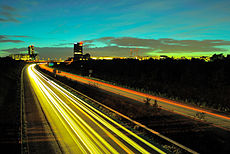 Developing skyline of the district Ørestad, located in the outskirts of Copenhagen. 12 towers expected to form the final skyline.
Developing skyline of the district Ørestad, located in the outskirts of Copenhagen. 12 towers expected to form the final skyline.
Recent years have seen a boom in modern architecture in Copenhagen[34] both when it comes to Danish architecture and works by international architects. For a few hundred years, virtually no foreign architects had worked in Copenhagen but since the turn of the millennium the city and its immediate sourroundings have seen buildings and projects from international star architects. In the same time, a number of Danish architects have achieved success in Copenhagen and abroad. Buildings in Copenhagen have won RIBA European Awards four years in a row ("Sampension" in 2005,[35] "Kilen" in 2006,[36] "Tietgenkollegiet" in 2007[37] and the Royal Playhouse in 2008.[38]) The last three mentioned projects are all by Lundgaard & Tranberg Architects.[39] At the 2008 World Architecture Festival in Barcelona, Bjarke Ingels Group won an award for the World's Best Residential Building 2008 for a house in Ørestad.[40] The Forum AID Award for Best building in Scandinavia went to Copenhagen buildings both in 2006[41] and 2008.[42] In 2008 British design magazine Monocle named Copenhagen the World's best design city 2008.[43]
The boom in urban development and modern architecture has brought some changes to the city's skyline. A political majority has decided to keep the historical centre free of high-rise buildings, but several areas will see or have already seen massive urban development. Ørestad now has seen most of the recent development. Located near Copenhagen Airport, it currently boasts one of the largest malls in Scandinavia and a variety of office and residential buildings as well as IT University and a high school. The two largest hotels in Scandinavia are currently under construction (ultimo 2008).
An ambitious regeneration project will create a new Carlsberg District at the historical premises of the Carlsberg Breweries that has terminated the production of beer in Copenhagen and moved it to Fredericia. The district will have a total of nine high-rise buildings and seeks to mix the old industrial buildings with modern architecture to create a dense, maze-like quarter with a focus on sustainability and an active urban life. A third major area of urban development also with a focus on sustanibility is Nordhavn. The Copenhagen tradition with urban development on artificial islands that was initiated with Christian IV's construction of Christianshavn has recently been continued with the creation of Havneholmen as well as a canal district at Sluseholmen in the South Harbour. A district in Copenhagen with a different take on modern architecture is that of Christiania whose many creative and idiosyncratic buildings are exponents of an "architecture without architects".
Parks
Main article: Parks and open spaces in CopenhagenCopenhagen is a green city with many big and small parks. King's Garden, the garden of Rosenborg Castle, is the oldest and most visited park in Copenhagen.[44] Its landscaping was commenced by Christian IV in 1606. Every year it sees more than 2.5 million visitors[45] and in the summer months it is packed with sunbathers, picnickers and ballplayers. It serves as a sculpture garden with a permanent display of sculptures as well as temporary exhibits during summer.[44] Also located in the city centre are the Botanical Gardens particularly noted for their large complex of 19th century greenhouses donated by Carlsberg founder J. C. Jacobsen.[46] Fælledparken is at 58 hectares the largest park in Copenhagen.[47] It is popular for sports and hosts several annual events such as a free opera concert at the opening of the opera season, other open-air concerts, carnival, Labour Day celebrations and Copenhagen Historic Grand Prix, which is a race for antique cars. A historical green space in the northeastern part of the city is Kastellet, a well-preserved renaissance citadel that now serves mainly as a park. Another popular park is the Frederiksberg Garden, a 32-hectare romantic landscape park. It houses a colony of tame grey herons and other waterfowl. The park offers views of the elephants and the elephant house designed by world-famous British architect Norman Foster of the adjacent Copenhagen Zoo, the largest zoo in Denmark.
In Copenhagen, many cemeteries double as parks, though only for the more quiet activities such as sunbathing, reading and meditation.[48] Assistens Cemetery, the burial place of Hans Christian Andersen, is an important green space for the district of Inner Nørrebro and a Copenhagen institution. The lesser known Vestre Kirkegaard is the largest (54 hectares) cemetery in Denmark[49] and offers a maze of dense groves, open lawns, winding paths, hedges, overgrown tombs, monuments, tree-lined avenues, lakes and other garden features.
It is official municipal policy in Copenhagen that all citizens by 2015 must be able to reach a park or beach on foot in less than 15 minutes.[50] In line with this policy, several new parks are under development in areas lacking green spaces.[51][52]
Beaches
Copenhagen and the surrounding areas have 3 beaches with a total of approx. 8 km of sandy beaches within 30 minutes cycling from the city centre. This includes Amager Strandpark, which opened in 2005 and includes a 2 km long artificial island and a total of 4.6 km of beaches,[53] located just 15 minutes by bicycle or a few minutes by metro from the city centre.
The beaches are supplemented by a system of Harbour Baths along the Copenhagen waterfront. The first and most popular of these is located at Islands Brygge[54] and has won international acclaim for its design.[55]
Demographics
As of 2010, 78.4% of Copenhagen's population is Danish, 7.0% are immigrants from western countries and 14.47% of a non-Western background.[56]
Depending on the boundaries used, the population of Copenhagen differs. Statistics Denmark uses a measure of the contiguously built-up urban area of Copenhagen, this means the number of communities included in this statistical abstract has changed several times, in the abstracts latest edition with about 1.2 million (1,199,224 (2011)) inhabitants. This number is not a strict result of the commonly used measuring methods of 200 meters of continuously build-up area, as there are exceptions to the general rule: The suburbs of Birkerød and Hørsholm are excluded, while all of Brøndby and parts of Ishøj and Greve are included.[citation needed] Statistics Denmark has never stated the geographical area of urban Copenhagen. However, we know it consists of Copenhagen Municipality, Frederiksberg and 16 of the 20 municipalities in the old counties Copenhagen and Roskilde, though 5 of them only partially.[57]
Statistics Denmark has worked out definitions of so-called lands (landsdele), a definition used to meet statistical needs on a lower level than regions. From this, the land of Copenhagen city (København by) is defined by the municipalities of Copenhagen, Dragør, Frederiksberg and Tårnby, with a total population of 667,228 in the beginning of 2009.[30][31] The surroundings of Copenhagen is defined by another land, Copenhagen suburban (Københavns omegn), which includes the municipalities of Albertslund, Ballerup, Brøndby, Gentofte, Gladsaxe, Glostrup, Herlev, Hvidovre, Høje-Taastrup, Ishøj, Lyngby-Taarbæk, Rødovre and Vallensbæk, and with a total population of 508,183 (1 January 2009).[30][31] This gives a total population of 1,171,709 for these two lands together. The lands of Copenhagen city and Copenhagen suburban can together be used as a definition of the metropolitan area, although perhaps a somewhat narrow one.
From 1 January 2009 the population of the 34 municipalities closest to and including the municipality of Copenhagen is 1.875.179.[58] Land area: 2,923 km². (Capital Region – Bornholm + East Zealand + Stevns) .[59] Thus, the region comprises 6.8% of the land area of Denmark, but has 34% of Denmark's population. This gives a total of 667 inhabitants per km² or 1,660 per square mile for the region. This compares with a population density in the rest of the country of approximately 90 per km² or around 230 per square mile.
Based on a 10%-isoline (data from 2002) in which at least 10% commutes into central parts of the Copenhagen area, most of Zealand would be covered and this area has a population of about 2.3 million inhabitants.[60]
Since the opening of the Øresund Bridge in 2000, commuting between and integration of Greater Malmö and Copenhagen have increased rapidly, and a combined statistical metropolitan area has formed. This combined metropolitan area has a population of 2,488,551 (2009).
A high-ranking civil servant of the Interior Ministry, Henning Strøm, who was involved in (i.e. known as "the Father of") a past municipal reform, which took effect on 1 April 1970, said on television, broadcast in connection with the recent Kommunalreformen ("The Municipal Reform" of 2007), that Copenhagen municipality would encompass an area with 1.5 million inhabitants, if the principles of the 1970 municipal reform were also applied on Copenhagen municipality.[61] In other words: in the rest of Denmark the city occupies only part of the municipality, but in Copenhagen the municipality of Copenhagen occupies only part of the city of Copenhagen.
Culture and recreation
Since the late 1990s, Copenhagen has undergone a transformation from a cozy Scandinavian capital to a cool metropolitan city of international scope in the league of cities like Barcelona and Amsterdam.[62] This is due to massive investments in infrastructure as well as culture and a wave of new successful Danish architects, designers and chefs.[6][34]
Museums
See also: List of museums in and around CopenhagenCopenhagen has a wide array of museums of International standard. The National Museum, Nationalmuseet, is Denmark's largest museum of Archaeology and cultural history, comprising the histories of Danish and foreign cultures alike. The National Gallery – "Statens Museum for Kunst" – is Denmark's national art museum and contains collections dating from 12th century and all the way up to present day artists. Among artists represented in the collections are Rubens, Rembrandt, Picasso, Braque, Léger, Matisse and Emil Nolde.
Another important Copenhagen art museum is the Ny Carlsberg Glyptotek founded by second generation Carlsberg tycoon-philanthropist Carl Jacobsen and is built around his personal collections. Its main focus is classical Egyptian, Roman and Greek sculptures and other antiquities and a collection of Rodin sculptures that is the largest outside France[63] (Glypto-, from the Greek root glyphein, to carve and theke, a storing-place). Besides its sculpture collections, the Ny Carlsberg Glyptotek also holds a comprehensive collection of paintings of impressionist and post-impressionist painters such as Monet, Renoir, Cézanne, van Gogh and Toulouse-Lautrec as well as Danish Golden Age painters.
Louisiana is a museum of modern art situated on the coast just north of Copenhagen. It is located in the middle of a sculpture garden on a cliff overlooking Øresund. The museum is included in the Patricia Schultz book 1,000 Places to See Before You Die. The Danish Museum of Art & Design is housed in the 18th century former Frederiks Hospital and displays Danish design as well as international design and crafts.
Other museums include:
- Thorvaldsens Museum is a single-artist museum dedicated to the oeuvre of romantic Danish sculptor Bertel Thorvaldsen who lived and worked in Rome.
- Cisternerne is a small but different museum dedicated to modern glass art. It is located in some grotto-like former cisterns that come complete with Stalactites formed by the changing water levels.
- The Ordrupgaard Museum is an art museum located just north of Copenhagen in an old mansion with an extension by Iraqi-British architect Zaha Hadid. It features 19th century French and Danish art and is particularly noted for its works by Paul Gaugin.
Performing Arts
Copenhagen Opera House as seen from the Royal Playhouse
The new Copenhagen Concert Hall opened in January 2009. It is designed by Jean Nouvel and has four halls with the main auditorium seating 1800 people. It serves as the home of the Danish National Symphony Orchestra and along with the Walt Disney Concert Hall in Los Angeles the most expensive concert hall ever built.[64] Another important venue for classical music is the Tivoli Concert Hall located in the historical Tivoli Gardens. The Copenhagen Opera House (in Danish usually called Operaen) that opened in 2005 and is designed by Henning Larsen, is the national opera house of Denmark and among the most modern opera houses in the world. The old Royal Danish Theatre dating from 1748 still works as a supplementary opera scene. The Royal Danish Theatre is also home to the Royal Danish Ballet. Founded in 1748 along with the theatre, it is one of the oldest ballet troupes in Europe. It is home to the Bournonville style of ballet.
Copenhagen has a significant jazz scene that has existed for many years. It developed when a number of American jazz musicians such as Ben Webster, Thad Jones, Richard Boone, Ernie Wilkins, Kenny Drew, Ed Thigpen, Bob Rockwell, Dexter Gordon, and others such as rock guitarist Link Wray came to live in Copenhagen during the 1960s. Every year in early July Copenhagen's streets, squares and parks fill up with big and small jazz concerts during the Copenhagen Jazz Festival (see yearly events). The most important venue for rhythmical music in Copenhagen is Vega in Vesterbro district which has been chosen as "best concert venue in Europe" by international music magazine Live[65]
For free entertainment one can stroll along Strøget, especially between Nytorv and Højbro Plads, which in the late afternoon and evening is a bit like an impromptu three-ring circus with musicians, magicians, jugglers and other street performers.
Sports
Copenhagen has a wide variety of sport teams. The major football teams are F.C. Copenhagen and Brøndby. FC København plays at Parken in Østerbro, Copenhagen. Other teams are Fremad Amager, B93, AB, Frem, Lyngby and Hvidovre IF.
Copenhagen also has multiple ice hockey teams, of which two are playing in the top league, AL-Bank Ligaen, namely Rødovre Mighty Bulls and Hvidovre Ligahockey.
World ranked no.2, Peter Gade, is one of the world's best international badminton players.
There are a lot of handball teams in Copenhagen. FC København owns both a women's and a men's team, which have the same name and logo. They were formerly known as FIF. Of other clubs playing in the "highest" leagues there are; Ajax Heroes, Ydun, and HIK (Hellerup).
Rugby union is also played in the Danish capital with teams such as CSR-Nanok, Copenhagen Business School Sport Rugby and Rugbyklubben Speed. The Danish Australian Football League, based in Copenhagen is the largest Australian rules football competition outside of the English speaking world.
In 2011 Copenhagen will host the UCI Road World Championships.
Amusement parks
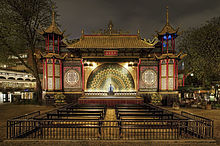 Built in 1874 the Pantomime Theatre is the oldest building in the Tivoli Gardens
Built in 1874 the Pantomime Theatre is the oldest building in the Tivoli Gardens
Copenhagen has the two oldest amusement parks in the World.[66] World-famous Tivoli Gardens is an amusement park and pleasure garden located right in the middle of Copenhagen between the City Hall Square and the Central Station. Among its rides are the oldest still operating roller coaster and the oldest ferris wheel in the World.[67] It also functions as an open-air concert venue. It opened on 15 August 1843 making it the second oldest amusement park in the world. Dyrehavsbakken (in English "the Deer Garden Hill") is located in Klampenborg a little north of Copenhagen in a forested area known as dyrehaven. Having been made into an amusement park complete with rides, games and restaurants by Christian IV, it is the oldest surviving amusement park in the World.[66]
Cuisine
As of 2009, Copenhagen has 13 Michelin star restaurants, the most of any Scandinavian city.[68] The city is increasingly recognized internationally as a gourmet destination.[69] Apart from the selection of upmarket restaurants, Copenhagen offers a great variety of Danish, international and ethnic restaurants. It is possible to find modest eateries serving open sandwiches ("smørrebrød") – the traditional and best known Danish lunch dish; however, most restaurants serve international dishes. Another local specialty, Danish pastry, can be sampled from any of numerous bakeries found in all parts of the city. The restaurant Noma (Short for Danish: nordisk mad English: Nordic food) was ranked as the Best Restaurant in the World by Restaurant in 2010 and 2011.[70]
Copenhagen has long been associated with beer. Carlsberg beer has been brewed at the brewery's premises at the border between Vesterbro and Valby districts since 1847 and has long been almost synonymous with Danish beer production. However, recent years have seen an explosive growth in the number of microbreweries so that Denmark today has more than 100 breweries,[71] many of which are located in Copenhagen. Some like Nørrebro Bryghus also act as brewpubs where it is also possible to eat at the premises.
Media
Many Danish media corroborations are located in Copenhagen. DR, the major Danish public service broadcasting corporation collected their activities in a new headquarters, DR byen, in 2006 and 2007. Similarly has Odense based TV2 collected its Copenhagen activities in a modern media house in the Teglholmen.[72] The two national daily newspapers Politiken and Berlingske Tidende and the two tabloids Ekstra Bladet and B.T. are based in Copenhagen. Other important media corporations include Aller Media which is the largest publisher of weekly and monthly magazines in Scandinavia, the Egmont media group and Gyldendal, the largest Danish publisher of books.
Copenhagen also has a sizable movie and television industry. Filmbyen, The Movie City, which is located in a former military camp in the suburb of Hvidovre and houses several movie companies and studio studios. Among the movie companies are Zentropa co-owned by Danish movie director Lars von Trier who is behind several international movie productions as well as a founding force behind the Dogma Movement.
Annual events
- Copenhagen Marathon, Copenhagen's annual marathon event
- Copenhagen Fashion Week takes place every year in February and August. It is the largest fashion event in Northern Europe.[73][74]
- Copenhagen Carnival takes place every year since 1982 during the Whitsun Holiday in Fælledparken and around the city. 120 bands, 2000 dancers and 100,000 spectators participate.[75]
- Copenhagen Distortion is a youth culture festival capturing the zeitgeist of the city, gathering every year (5 days up to the first weekend of June) up to 100.000 people in the streets, in shops, galleries, clubs, bars, in boats and buses, with a cultural focus on street culture, art and upfront dance music.[76]
- Roskilde Festival is a music festival held every year in Roskilde west of Copenhagen. Gathering around 100,000 people every year, it is one of the four largest rock music festivals in Europe.
- Copenhagen Jazz Festival, which begins on the first Friday in July, is a popular annual event that is the result of Copenhagen's significant jazz scene. The festival takes place throughout the city in streets, squares and parks as well as in cafés and concert halls.[77] It embraces around 900 concerts, 100 venues and over 200,000 guests from Denmark and around the world. It is recognized as one of the leading jazz festivals in the World.[78][79]
- Copenhagen Pride is a gay pride festival taking place every year in August. Among the events is "Tivoli goes pink" and it ends with a parade.[80]
- Round Christiansborg Open Water Swim Race is a 2 km open water swimming competition taking place each year in late August. This amateur event is combined with a 10 km Danish championship. In 2009 the event included a 10 km FINA World Cup competition in the morning.
- Copenhagen Cooking takes place in August every year and is a food festival with a wide array of events all over the city.
- CPH:PIX is Copenhagen's international feature film festival, established in 2009 as a fusion of the 20-year-old Natfilm festival and the 4-year-old CIFF. The CPH:PIX festival takes place in mid-April.[81]
- CPH:DOX is Copenhagen's international documentary film festival, every year in November. On top of its documentary film programme of over 100 films, CPH:DOX includes a wide event programme with dozens of events, concerts, exhibitions and parties all over town.[81]
- Copenhell is an outdoor metal festival located on Refshaleøen in Copenhagen. Everything from death metal to hard rock is played on two scenes: Helvíti and Hades.
Economy
Copenhagen is the economic and financial centre of Denmark[82] and also strong business and economic centre in the Scandinavian-Baltic region. Around 3.5 million inhabitants live within a 50 km (31 mi) radius of Copenhagen, making the city centre of the most dense and populated area in Northern Europe.[83] The region generates approximately 25 per cent of both Sweden's and Denmark's GDP.[84] In 2008, Copenhagen was ranked 4th by Financial Times-owned FDi magazine on their list of Top 50 European Cities of the Future after London, Paris and Berlin.[85] In 2006/07 FDi Magazine named Copenhagen Scandinavian City of the Future[86] and in 2004/05 Copenhagen was named Northern European City of the Future ahead of other cities from Scandinavia, UK, Ireland and Benelux.[87] In the 2008 Worldwide Centers of Commerce Index, published by MasterCard, Copenhagen was ranked 14th in the world and 1st in Scandinavia.[88] Copenhagen is one of the cities in Western Europe attracting most regional headquarters and distribution centres.[89] Among the international companies that have chosen to locate their regional headquarters in Copenhagen is Microsoft. There are 2,100 foreign companies located in the Copenhagen area, of which approx. 500 are Scandinavian head offices, representing a wide range of industries.
 Scandinavian headquarters for the Swiss pharmaceutical company Ferring Pharmaceuticals with the metro in front
Scandinavian headquarters for the Swiss pharmaceutical company Ferring Pharmaceuticals with the metro in front
Copenhagen has a service oriented economy. An important sector is life science and research & development plays a major role in the economy of the city. The entire Oresund Region is in cooperation with Sweden being promoted as Medicon Valley. Major Danish biotech companies like Novo Nordisk and Lundbeck, both of which are among 50 largest pharmaceutical and biotech companies in the World, are located in the greater Copenhagen area.[90] The region also boasts the largest IT-cluster in Scandinavia with nearly 100,000 employees.[91] Shipping is also an import business with Maersk, the World's largest shipping company, having their world headquarters in Copenhagen.
Several international companies have established their regional headquarters in Copenhagen, for example, Microsoft. Maersk, the world's largest container shipping company, has their world headquarters in Copenhagen. A substantial number of Danish pharmaceuticals such as Novo Nordisk, Ferring Pharmaceuticals and Bavarian Nordic also operate in the area, having placed their headquarters in or close to Copenhagen.[90]
Copenhagen has some of the highest gross wages in the world.[92] High taxes mean that wages are reduced after mandatory deduction. A beneficial researcher scheme with low taxation of foreign specialists[93] has made Denmark an attractive location for foreign labour to settle. Copenhagen is however also among the most expensive cities in Europe.[94][95]
Education, science, research
Copenhagen has a well-developed higher education system of public universities. The city has a higher education student population of at least 89,000, combining the numbers of the largest universities and institutions: University of Copenhagen (40,000 students), Copenhagen Business School (17,000 students), Metropolitan University College and University College Copenhagen (10,000 students each), Technical University of Denmark (7,000 students), KEA (3,000 students) and IT University of Copenhagen (2,000 students.) Most prominent among these is the University of Copenhagen. Founded in 1479, it is the oldest university in Denmark. It is a world-renowned research and teaching institution with campuses around the city and forms part of the International Alliance of Research Universities (IARU), which is a collaboration between international top universities including Oxford, Cambridge, Yale, Berkeley and The Australian National University. The University attracts app. 1500 international and exchange students every year.[96] It is repeatedly ranked as one of the best universities in Europe. At the Times Higher Education-QS World University Rankings 2008 list, it was ranked as fourth best in continental Europe.[97] The Academic Ranking of World Universities 2008 placed it as number 43 worldwide and 8th in Europe.[98] A second all-round university in the Copenhagen area is Roskilde University located in Roskilde.
The Technical University of Denmark (DTU), Danmarks Tekniske Universitet, is located in Lyngby at the northern outskirts of Copenhagen. In 2008 it was ranked third highest in Europe on Times Higher Education's list of the most influential technical universities in the World. The Max Planck Institute in Germany was ranked 15, ETH Zurich in Switzerland was ranked 15 and DTU in Denmark was ranked 20.[99]
Copenhagen Business School (CBS) is an esteemed and EQUIS accredited business school located in Frederiksberg.
The IT University of Copenhagen is Denmark's youngest university, a mono-faculty institution focusing on technical, societal and business aspects of information technology.
There are also branches of both University College Capital and Metropolitan University College inside and outside Copenhagen.
Medicon Valley
Main article: Medicon ValleyCopenhagen is rich in companies and institutions with a focus on research and development within the biotechnology[100] and life science sectors. Two of the 50 largest pharmaceutical and biotech companies in the World are located in the greater Copenhagen area. The biotech and life science cluster in Copenhagen and the rest of the Oresund Region is one of the strongest in Europe. Since 1995 this has been branded as the Medicon Valley in a Danish-Swedish cooperation. The aim is to strengthen the region's position and to promote cooperation between companies and academia. The German biotech giant Sartorius Stedim Biotech is currently creating a Nordic head office in Tåstrup on the outskirts of Copenhagen. The Øresund region is responsible for 60 percent of life science production in Scandinavia and is home to 111 biotech companies.[101]
Cleantech
Copenhagen was mentioned by Clean Edge as one of the key cleantech clusters to watch in their 2008 book The Cleantech Revolution. The city is the focal point for more than 300 cleantech companies drawing on 46 research institutions. The cluster employs more than 60.000 people and is characterized by a close collaboration between universities, business and governing institutions. The regions most important cleantech research institutions are the University of Copenhagen, Copenhagen Business School,[102] Risø DTU National Laboratory for Sustainable Energy and the Technical University of Denmark which Risø is now part of.
Transport
The greater Copenhagen area has a very well established transportation infrastructure making it a hub in Northern Europe.
Roads
Copenhagen has a large network of toll-free motorways and public roads connecting different municipalities of the city together and to Northern Europe.[103] As in many other cities in Europe traffic is increasing in Copenhagen. The radial arterial roads leading to Copenhagen city centre are critically congested during peak hours.[104]
Cycling
Main article: Cycling in CopenhagenCopenhagen is known as one of the most bicycle-friendly cities in the world.[105] Every day 1.1 million km are bicycled in Copenhagen.[106] 36% of all citizens commute to work, school or university by bicycle[107] and it is municipal policy that this number should go up to 40% by 2012 and 50% in 2015.[108] The city's bicycle paths are extensive and well used. Bicycle paths are often separated from the main traffic lanes and sometimes have their own signal systems.
The municipality is also developing a system of interconnected green bicycle routes, greenways, the aim being to facilitate fast, safe, and pleasant bicycle transport from one end of the city to the other. The network will cover more than 100 km (62 mi) and will have 22 routes when finished.[108] The city provides public bicycles which can be found throughout the downtown area and used with a returnable deposit of 20 kroner.
Copenhagen's well-developed bicycle culture is reflected in the use of copenhagenize to describe the practice of other cities adopting Copenhagen-style bike lanes and bicycle infrastructure.[109] In 2007, Copenhagen-based Danish urban design consultant Jan Gehl was hired by the New York City Department of Transportation to re-imagine New York City streets by introducing designs to improve life for pedestrians and cyclists.[110] In recognition of Copenhagen's emphasis on bicycling, the city has been chosen by the Union Cycliste Internationale as their first official Bike City. Bike City Copenhagen will take place from 2008 to 2011 and consist of large cycling events for professionals as well as amateurs.[107]
Harbour
The harbour of Copenhagen has largely lost its industrial importance. In 2001, Copenhagen Harbour merged with the harbour in Malmö to create Copenhagen-Malmö Port. It has several functions, the most important being as a major cruise destination. In 2007 a record 286 cruise ships with 420,000 cruise passengers visited Copenhagen. 120 of these ships either started or ended the cruise in Copenhagen.[111] In 2008 these numbers grew further to 310 cruise ships and 560,000 passengers.[112] As a result of the growth in the cruise industry facilities are being expanded and improved.[113] At the World Travel Awards in 2008, Copenhagen Port was named the number one cruise destination in Europe for the fifth year in a row.[114]
Copenhagen is serviced by ferry lines to Oslo in Norway (called "Oslobåden") with a daily connection[115] and to Świnoujście in Poland (called "Polensfærgerne") with five weekly connections (Passengers are taken by bus to Ystad (Sweden) and ferry starts there).[116]
Copenhagen has four lines of waterbuses, known as the Copenhagen Harbour Buses, serving ten water bus stops; four on the Amager-side and six on the Zealand-side of the harbour, from Sluseholmen in the South to Holmen in the North.
Airports
Copenhagen Airport is the principal airport serving Copenhagen. It is the largest in Scandinavia and the 17th largest in Europe.[3] Located in Kastrup on the island of Amager, it has efficient connections to downtown Copenhagen, with trip times of 15 minutes to Kongens Nytorv via metro (with 4–6 minutes between departures) and 12 minutes to Central Station via regional train (10 minutes between departures). Its location also makes it the most important international airport for large parts of southern Sweden. Over the Øresund Bridge trains go to Malmö South in 14 minutes or Malmö Central Station in 22 minutes.[117] Skytrax rates Copenhagen Airport as the tenth best airport in the world, and the fourth best in Europe.[118] The Roskilde airport, 30 km west of city center, has two (crossing) runways with ILS equipment. It is primarily used for general aviation traffic, flight schools, business jets and occasional charter flights, but can be used by medium jets - although not always at full take-off weight. Plans for expanding Roskilde Airport have been approved, making it more suitable for regular flights of medium jets, such as those operated by most low-cost airlines and charter operators. However, a lack of firm commitment from airlines has postponed the expansion indefinitely.
Public transportation
The Øresund Bridge, the longest road and rail bridge in Europe, connecting Copenhagen with Malmö, the third largest city of Sweden.
 Underground Metro station in Frederiksberg
Underground Metro station in Frederiksberg
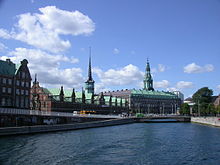 Christiansborg Palace – home of the Danish Parliament Folketinget, the Supreme Court, Office of the Prime Minister and official reception area of Queen Margrethe II and the former stock exchange Børsen
Christiansborg Palace – home of the Danish Parliament Folketinget, the Supreme Court, Office of the Prime Minister and official reception area of Queen Margrethe II and the former stock exchange Børsen
 Nyhavn, the 17th century waterfront
Nyhavn, the 17th century waterfront
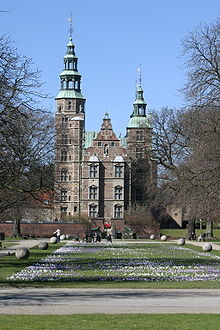 Rosenborg Castle in central Copenhagen
Rosenborg Castle in central Copenhagen
 Transition from Terminal 2 to Terminal 1 at the largest airport in Scandinavia, Copenhagen Kastrup Airport
Transition from Terminal 2 to Terminal 1 at the largest airport in Scandinavia, Copenhagen Kastrup Airport
- Local transport
The local transportation system of Copenhagen consists of a number of different, but combined, train systems and several types of buses. The four different rail systems are
- Re-tog regional trains (stops at major stations only, continues as interregional trains outside Copenhagen local traffic area)
- S-train (a combined urban and suburban rail system with a length of 170 km (105.63 mi)., the distance between stations is approximately 2 km (1.24 mi) within the central parts)
- Copenhagen Metro (under further development, the City Circle Line (M3+M4) is scheduled to be complete in 2018 with plans for three additional lines M5+M6+M7[119])
- Local trains in the periphery of the metropolitan area. (modern but usually driven by diesel or natural gas)
There are 193 rail stations. Most of them have connecting bus services. This link shows all lines, stations and fare zones. The Copenhagen local traffic area is divided in 95 zones. Zones 1,2 and 3 make up the city core of Copenhagen.
- Tickets
The same ticket is valid for travel on bus, train, and metro networks. Ticket machines are installed at all stations, and tickets can also be bought on buses and at ticket counters located at major stations. A ticket price inside the Copenhagen local traffic area is distance-dependent and always between two and nine zones (a nine zone ticket goes for all zones). Price is currently (2011) 12 DKK for each zone. There are a number of tickets that can be bought at different discounts, for instance the 10-trip klippekort (variable price) or 24 hour travel card (130 DKK). The fine for not having a valid ticket is 750DKK.
The main junction stations for interchange between system or lines are the stations of Nørreport, Valby, Danshøj, Kastrup Airport, Ny Ellebjerg, Hellerup, Østerport, Ryparken, Ørestaden, Flintholm, and København H (Copenhagen Central Station). The latter is also a hub for trains with destinations outside the Copenhagen local traffic area.
- Danish and international trains
Copenhagen Central Station provides Copenhagen with Intercity and Express trains across Denmark, as well as services to several international destinations. The train traffic to Hamburg is especially heavy, and other distant destinations can also be reached by daily international trains. Trains to southern and western Sweden depart every 20 minutes. (A special ticket fare system exists between the Copenhagen local traffic area and the most southern part of Sweden, Skåne county.)
Environment
Copenhagen is recognized as one of the most environmentally friendly cities in the world.[120] Much of the city's success can be attributed to a strong municipal policy combined with a sound national policy, in 1971 Denmark established a Ministry of Environment and the first country in the world to implement an environmental law in 1973. In 2006 Copenhagen Municipality received the European Environmental Management Award.[121] The award was given for long-term holistic environmental planning. It is municipal policy to reduce CO2 emissions by 20% before the end of 2015.[122] In 2001 a large offshore wind farm was built just off the coast of Copenhagen at Middelgrunden. It produces about 4% of the city's energy.[123]
Many years of major investments in sewage treatment has improved water quality in the harbour to an extent that the inner harbour can be used for swimming and facilities for this are provided at a number of locations.[124]
Another municipal policy is that 40% of all citizens should bicycle to and from work by 2012 and a number of initiatives are being taken to implement this policy (see "bicycling" above).[125]
Copenhagen is the capital in the world where organic food has the largest market share. One in every ten purchases is organic in Copenhagen.[126] Within the municipal sector in Copenhagen, 45% of all food consumption is organic but the target is considerably higher. With the environmental strategy "Environment Metropolis: Our Vision 2015" the politicians wish that solely organic food is to be served in 90 per cent of the Copenhagen old-age homes and residential homes for children and young persons in 2015.[126]
International rankings
Copenhagen has placed well in a number of international rankings, some of which are mentioned below.
General rankings and comment
- Copenhagen is ranked 11th in Mercer's Quality of Living global city rankings 2009.[127]
- It was ranked No.1 as Most Livable City in the World by international lifestyle magazine Monocle on their Top 25 Most Livable Cities 2008 list[128] and World's Best Design City 2008 also by Monocle. In 2010, Monocle ranked Copenhagen as the 2nd most liveable city, losing the top spot to Munich.[128]
- In 2008, Copenhagen was ranked No.4 by Financial Times-owned FDi magazine on their list of Top50 European Cities of the Future after London, Paris and Berlin.[85] In 2006/07 FDi Magazine named Copenhagen Scandinavian City of the Future[86] and in 2004/05 Copenhagen was named Northern European City of the Future ahead of other cities from Scandinavia, UK, Ireland and Benelux.[87]
- It is the world's No.7 most expensive city and No.3 most expensive in Europe on the Forbes List.[129]
Business and commerce rankings
- In 2009, Copenhagen was named an Innovation Nexus City and ranked 12th in Europe and 17th globally for innovation across 31 sectors, out of 256 cities in the Innovation Cities Index published by 2thinknow.[130]
- In the 2008 Worldwide Centers of Commerce Index, published by MasterCard, Copenhagen was ranked 14th in the world and 1st in Scandinavia.[88]
- In The 2008 Global Cities Index, Copenhagen was ranked 36th in the world, 15th in Europe, and 2nd in Scandinavia.[131]
- Copenhagen ranks 3rd in Western Europe and 1st in the Nordic countries for attracting head offices.[132]
- Copenhagen No.1 out of 254 locations in the Location Ranking Survey performed by ECA International that has asked European experts where they prefer to be stationed worldwide.[133]
- It is ranked No.7 as Preferred City For Investment Projects.[134]
- It ranked 3rd in Western Europe in terms of attracting regional headquarters and distribution centres, only surpassed by London and Paris.[89]
- It ranks No.1 in the 2006 Global Earning Ranking.[135]
- The city ranks as the 5th most popular city in the world for international meetings and conferences.[136]
- The Copenhagen Metro has been named the Greenest City in Europe by Siemens/Economist Intelligence Unit.[137]
- It was ranked No.6 in Grist Magazine's "15 Green Cities" list in 2007 making Copenhagen the greenest capital of Scandinavia according to Grist Magazine.[138]
- The Copenhagen Metro has been named the Best Metro in the World by industry experts.[139]
- Travellers have voted Copenhagen the cleanest city in Europe.[140]
- Lonely Planet ranks Copenhagen as Scandinavia's 'coolest' capital .[citation needed]
- Copenhagen was ranked as one of the most attractive cities to live and work in Europe.[141]
Notable residents
- Herman Bang, journalist and author
- Niels Bohr, physicist and Nobel Prize winner
- Aage Bohr, physicist and Nobel Prize winner (son of Niels Bohr)
- Victor Borge, entertainer
- August Bournonville, ballet choreographer
- Georg Brandes, cultural and literary critic
- Helena Christensen, supermodel
- Tove Ditlevsen, author
- Carl Th. Dreyer, movie director
- Rune Glifberg, skateboarder
- Gus Hansen, poker player
- Iben Hjejle, actor
- Peter Høeg, author
- Bjarke Ingels, architect and founder of BIG
- Arne Jacobsen, architect and designer
- J. C. Jacobsen, founder of the Carlsberg Carlsberg Brewery
- Robert Jacobsen artist
- C.V. Jørgensen, singer and songwriter
- Søren Kierkegaard, philosopher
- Kim Larsen, singer, guitarist and songwriter
- Michael Laudrup, former football player, currently coach
- Bjørn Lomborg, political scientist and author
- Lauritz Melchior, opera singer
- Mads Mikkelsen, actor
- Dirch Passer, comedian and actor
- Peter Schmeichel, TV host, former footballer
- Julius Thomsen, chemist
- Lars von Trier, film director
- Dan Turèll, author
- Lars Ulrich, drummer and songwriter for heavy metal band Metallica
International relations
See also: List of twin towns and sister cities in DenmarkPartnerships
Copenhagen does not have official sister cities, but maintains cooperation on specific areas with partner cities around the world:
See also
- Copenhagen Climate Council
- Oresund Region
- Ports of the Baltic Sea
- Transportation in Denmark
- 2009 United Nations Climate Change Conference in Copenhagen
References
Notes
- ^ "Region Hovedstaden" (in Danish). Region Hovedstaden. http://www.regionhovedstaden.dk/.
- ^ "General facts on The Øresund Region". Oresundsregionen.org. Archived from the original on 2009-06-01. http://web.archive.org/web/20090614174123/http://www.oresundsregionen.org/3d200029. Retrieved 5 May 2009.
- ^ a b "Copenhagen Airport". waymarking.com. http://www.waymarking.com/waymarks/WM3N4X.
- ^ "Copenhagen Region Ranks 3rd in Western Europe for Attracting Head Offices". Ministry of Foreign Affairs of Denmark. 6 January 2009. Archived from the original on 9 May 2008. http://web.archive.org/web/20080509015917/http://www.ambottawa.um.dk/en/servicemenu/News/Copenhagen+region+ranks+3rd+in+western+EuropeForAttractingHeadOffices.htm. Retrieved 24 July 2009.
- ^ "A great place to live". Ministry of Foreign Affairs of Denmark. http://www.investindk.com/visArtikel.asp?artikelID=8130.
- ^ a b c "Copenhagen is Scandinavia's most desirable city". International Herald Tribune. http://www.iht.com/articles/2007/06/18/arts/rmon2copenhagen.php.
- ^ "Europe's 10 Best Places To Live". Forbes. http://www.forbes.com/2008/07/21/cities-europe-lifestyle-forbeslife-cx_vr_0721europe.html.
- ^ "Copenhagen – City of Cyclists". City of Copenhagen. Archived from the original on 2010-08-01. http://web.archive.org/web/20100701074958/http://www.kk.dk/sitecore/content/Subsites/CityOfCopenhagen/SubsiteFrontpage/CitizenInformation/CityAndTraffic/CityOfCyclists.aspx.
- ^ "Cool Boom Towns". Spiegel Special. http://wissen.spiegel.de/wissen/image/show.html?did=57570816&aref=image037/2008/06/21/ROSPC200800400660071.PDF&thumb=false.
- ^ Forbes: The World's Most Expensive Cities For Expats
- ^ Arkæologer graver ny teori om København op af mulden (Archeologists develop new theory about Copenhagen from their digs), Videnskab.dk, 5 November 2008
- ^ Biography of George de Hevesy
- ^ "Copenhagen". Christopher Woodward (1998). Manchester University Press ND. p. 10. ISBN 0719051932
- ^ a b c "Battle of Copenhagen, April 2, 1801. Prelude " Age Of Sail". ageofsail.wordpress.com. http://ageofsail.wordpress.com/2009/04/02/battle-of-copenhagen-april-2-1801-prelude/.
- ^ "History of THE NAPOLEONIC WARS". www.historyworld.net. http://www.historyworld.net/wrldhis/PlainTextHistories.asp?historyid=aa13.
- ^ "Napoleonic War: Battle of Copenhagen 1801". www.historyofwar.org. http://www.historyofwar.org/Maps/maps_copenhagen3.html.
- ^ a b c d e "History of NAPOLEON BONAPARTE". www.historyworld.net. http://www.historyworld.net/wrldhis/PlainTextHistories.asp?gtrack=pthc&ParagraphID=mfa.
- ^ Dudley Pope, The Great Gamble: Nelson at Copenhagen (1972)
- ^ a b c d e Davies, Peter (3 September 2007). "Copenhagen's second battle remembered – 200 years on". The Times (UK). http://www.timesonline.co.uk/tol/life_and_style/court_and_social/article2372230.ece.
- ^ The Battle of Copenhagen
- ^ Tom Pocock, Horatio Nelson, Pimlico (1987), p. 229
- ^ Smith, D. The Greenhill Napoleonic Wars Data Book. Greenhill Books, 1998, p. 204
- ^ a b "Defying Napoleon (preface)". The History Press Ltd. http://www.thomasmunch-petersen.info/Welcome_files/preface.pdf.
- ^ "Copenhagen Cathedral on Fire". http://www.cityonfire.org/projects/Vor%20Frue/page10.html. Retrieved 2011-07-08.
- ^ Wendy Hinde, George Canning (Purnell Books Services, 1973), p. 168
- ^ RAF instruction film for precision bombing number 6
- ^ SFINX film/TV documentary "Sangbogen og de røde sko" (containing parts of the RAF precision bombing instruction film number 6) by Katia Forbert Petersen, produced by Anette Mari Olsen. DK&UK historical consultants Henrik Dahlman, Derek Carter. Archive films from BBC Motion Gallery, Imperial War Museum (London). Broadcast in Danish on the public service channel DR2 January 9th 2011. Film covers 2/3 of the school tragedy and 1/3 [?]. First Wikipedia staff from the UK that phones +46 418 301 114, and proves to have basic knowledge of WW2 I will send a DVD copy – it includes RAF file 6 as mentioned, interview with sir Basil Embry and the coded telegram from Ole Lippmann to Sir Basil Embry. (in English)
- ^ "Operation Carthage" by Kjeld Mahler Sasbye
- ^ "Københavns bydele". Københavns Kommune. http://www.kk.dk/FaktaOmKommunen/KoebenhavnITalOgOrd/StatistikOmKoebenhavnOgKoebenhavnere/Kort/KoebenhavnsBydele.aspx. Retrieved 3 May 2009.
- ^ a b c Statistics Denmark, table BEF1A07: Population 1 January by region, age, sex, marital status
- ^ a b c Statistics Denmark, definitions of lands as of 1 January 2007 (excel-file, in Danish)
- ^ The Finger Plan, Denmark.dk
- ^ "Weather Information for Copenhagen". World Weather Information Service. http://www.worldweather.org/173/c00190.htm. Retrieved 30 November 2009.
- ^ a b "B1 Kopenhagen entdecken". Baumeister – Zeitschrift für Architektur. http://www.baumeister.de/.
- ^ "RIBA European Awards 2005". RIBA. http://www.e-architect.co.uk/awards/riba_awards_2005.htm.
- ^ "RIBA European Awards 2006". RIBA. http://www.architecture.com/Awards/RIBAEuropeanAwards/2006/Kilen/KilenDenmark.aspx.
- ^ "RIBA European Awards 2007". RIBA. http://www.amblondon.um.dk/en/menu/TheEmbassy/News/RIBAAwardsToDanishArchitects.htm.[dead link]
- ^ "RIBA European Awards 2009". RIBA. http://www.architecture.com/Awards/RIBAEuropeanAwards/2008/RoyalPlayhouse.aspx.
- ^ Lundgaard & Tranberg Architects
- ^ "World's Best Residential Building 2008". World Architecture Festival. http://www.worldarchitecturefestival.com/news-detail.cfm?newsId=33.
- ^ "Controversial residential housing complex year’s best building". Forum AID. http://www.forumaid.com/default.asp?sid=1207.
- ^ "Ørestad Gymnasium Best Building in Scandinavia 2008". designboom. http://www.designboom.com/weblog/read.php?CATEGORY_PK=&TOPIC_PK=2388.
- ^ Dugan, Emily (9 June 2008). "World's best design city 2008". The Independent (UK). http://www.independent.co.uk/travel/news-and-advice/copenhagen-probably-the-best-city-in-the-world-842782.html.
- ^ a b "King's Garden". Slots- og Ejeondomsstyrelsen. Archived from the original on 29 March 2008. http://web.archive.org/web/20080329224035/http://www.ses.dk/392755f0.
- ^ "Kongens Have". AOK. http://www.aok.dk/byen-rundt/kongens-have.
- ^ "Botanisk Have". Carlsberg. http://www.carlsbergdanmark.dk/omos/Historie/IJacobsensfodspor/Kobenhavn/Pages/BotaniskHave.aspx.
- ^ "Fælledparken". AOK. http://www.aok.dk/byen-rundt/faelledparken.
- ^ "København får mere liv på kirkegårdene". Politiken. http://ibyen.dk/article241086.ece.
- ^ "Guide: Gå på opdagelse i de dødes haver". Politiken. http://ibyen.dk/guide/article327680.ece.
- ^ "En grøn og blå storby". Københavns Kommune. http://www.br.kk.dk/Politik%20og%20Demokrati/IPolitiskFokus/Miljoemetropolen/EnGronOgBlaaStorby.aspx. Retrieved 5 January 2009.
- ^ "Superkilen by Bjarke Ingels Group". Dezeen. http://www.dezeen.com/2008/10/05/suk-project-by-big-architects/. Retrieved 5 January 2009.
- ^ ""1001 Træ", Nordvest". Københavns Kommune. http://www2.kk.dk/kvarterloeft/pegasus.nsf/url/nordvest.
- ^ "Hot spot på Amager Strandpark". gomotion.dk. http://www.gomotion.dk/pe1.asp?p_id=335. Retrieved 14 January 2009.
- ^ Harbour bath at Islands Brygge, e-architect
- ^ "2007 IOC Honorable Mention". ap architecture-page. http://www.architecture-page.com/go/people/profiles/bjarke-ingels-group. Retrieved 5 January 2009.
- ^ "Befolkning". Kk.dk. http://www.kk.dk/FaktaOmKommunen/KoebenhavnITalOgOrd/StatistikOmKoebenhavnOgKoebenhavnere/StatistikPaaBydele/BefolkningOgFremskrivninger.aspx. Retrieved 2 June 2011.
- ^ Danmarks Statistik, Largest cities of Denmark 2007 (German)
- ^ Statistikbanken.dk Population table BEF1A07
- ^ Orienteering fra Københavns Kommune. Statistisk Kontor.2003 nr. 25
- ^ Andel af befolkningen der pendler til den centrale del a HUR-området
- ^ DR netnews 25-06-04
- ^ "Cool Boom Towns". Spiegel Special. http://wissen.spiegel.de/wissen/image/show.html?did=57570816&aref=image037/2008/06/21/ROSPC200800400660071.PDF&thumb=false. Retrieved 9 January 2009.
- ^ "Ny Carlsberg Glyptotek". AOK. http://www.aok.dk/udstilling/ny-carlsberg-glyptotek. Retrieved 9 January 2009.
- ^ "DRs koncerthus – et af verdens dyreste". Berlingske Tidende. http://www.berlingske.dk/article/20070209/danmark/102090998/. Retrieved 9 January 2009.
- ^ "VEGA". Wonderfull Copenhagen. http://www.visitcopenhagen.dk/presse/presseinformation/gaa_ud/vega_-_koncertsted_og_natklub. Retrieved 9 January 2009.
- ^ a b "Dyrehavsbakken". AOK. http://www.aok.dk/byen-rundt/bakken. Retrieved 5 January 2009.
- ^ Tivoli Gardens, the rides
- ^ [1][dead link]
- ^ The Top 10 cities to visit in 2009, TimesOnline
- ^ Telegraph – Noma in Copenhagen named best restaurant in the world – 26 April 2010.
- ^ Nyeste artikler fra Bryggeriforeningen, Bryggeriforeningen
- ^ "TV2 samles på Teglholmen". Berlingske Tidende. http://www.business.dk/article/20060515/nyhedsoversigt/105150198/. Retrieved 10 January 2009.
- ^ Fashion Capital Copenhagen
- ^ Copenhagen Fashion Week
- ^ "History of Copenhagen=copenhagennet.com". http://www.copenhagenet.dk/CPH-History.htm. Retrieved 30 May 2009.
- ^ Copenhagen Distortion
- ^ Copenhagen Jazz Festival 3+ years, Wonderful Copenhagen
- ^ Top 10 best Jazz Festivals, TripAdvisor
- ^ Copenhagen Jazz Festival
- ^ Copenhagen Pride
- ^ a b "Cph:Pix". Cphpix.dk. http://www.cphpix.dk. Retrieved 5 May 2009.
- ^ "Regionale regnskaber 2005 – Nyt fra Danmarks Statistik – Danmarks Statistik". Dst.dk. 3 July 2006. http://www.dst.dk/Statistik/Nyt/emneopdelt/nytsingle.aspx?countid=8883&ci=true&pti=1. Retrieved 5 May 2009.
- ^ Copenhagen – Overview, the Øresund Region
- ^ ABOUT THE ØRESUND REGION, the Øresund Region
- ^ a b Top 50 European City of the Future 2008/09
- ^ a b Scandinavian City of the Future 06/07
- ^ a b Northern European City of the Future 2004/05
- ^ a b (PDF) Worldwide Centers of Commerce Index. MasterCard. 2008. http://www.mastercard.com/us/company/en/insights/pdfs/2008/MCWW_WCoC-Report_2008.pdf. Retrieved 24 November 2008.
- ^ a b "Copenhagen Region Ranks 3rd in Western Europe for Attracting Head Offices". Ministry of Foreign Affairs of Denmark. 5 August 2008. Archived from the original on 2009-01-04. http://web.archive.org/web/20090104230626/http://www.ambottawa.um.dk/en/servicemenu/News/Copenhagen+region+ranks+3rd+in+western+EuropeForAttractingHeadOffices.htm. Retrieved 24 July 2009.
- ^ a b "Copenhagen – Overview". USA Today. 2 November 2007. http://www.usatoday.com/marketplace/ibi/copenhagen.htm. Retrieved 5 May 2009.
- ^ Copenhagen – Overview
- ^ "World's richest cities". City Mayors. http://www.citymayors.com/economics/richest_cities.html. Retrieved 5 May 2009.
- ^ Level of salary in Denmark
- ^ "World's most expensive cities (EIU)". City Mayors. http://www.citymayors.com/economics/expensive_cities_eiu.html. Retrieved 5 May 2009.
- ^ "World's most expensive cities – Ranking". City Mayors. http://www.citymayors.com/economics/expensive_cities2.html. Retrieved 5 May 2009.
- ^ "Internationalisation – University of Copenhagen". University of Copenhagen. http://facts.ku.dk/studerende/h_internationalisering/. Retrieved 10 January 2009.
- ^ "THE – QS World University Rankings 2008". Times Higher Education Supplement. http://www.topuniversities.com/worlduniversityrankings/results/2008/overall_rankings/fullrankings/. Retrieved 10 January 2009.[dead link]
- ^ "Top500 World Universities". Academic Ranking of World Universities. Archived from the original on 22 August 2008. http://web.archive.org/web/20080822124509/http://www.arwu.org/rank2008/ARWU2008_A(EN).htm. Retrieved 10 January 2009.
- ^ "Top 20 institutions in engineering based on impact". Times Higher Education Supplement. http://www.timeshighereducation.co.uk/story.asp?sectioncode=26&storycode=401979&c=1. Retrieved 10 January 2009.
- ^ Copenhagen Capacity , Infrastructure & logistics – Copenhagen a distribution hub. Retrieved 22 February 2007.
- ^ "Top 20 institutions in engineering based on impact". USA Today. http://www.usatoday.com/marketplace/ibi/copenhagen.htm. Retrieved 10 January 2009.
- ^ "The win-win ways of Cleantech business". CBS Observer. 26 March 2009. http://cbsobserver.dk/win-win-ways-cleantech-business. Retrieved 24 July 2009.
- ^ "Logistics". Copenhagen Capacity. http://www.copcap.com/content/us/doing_business/facts/infrastructure_and_logistics/logistics. Retrieved 5 January 2009.
- ^ "Light rail project in Copenhagen – the Ring 2½ corridor" (PDF). Centre for Traffic and Transport, DTU. http://www.trafikdage.dk/td/papers/papers06/Trafikdage-2006-556.pdf. Retrieved 5 January 2009.
- ^ "11 most bicycle-friendly cities in the world". Virgin Vacations. http://www.virgin-vacations.com/site_vv/11-most-bike-friendly-cities.asp. Retrieved 5 January 2009.
- ^ "Verdens bedste cykelby". Københavns Kommune. http://www.kk.dk/Borger/ByOgTrafik/cyklernesby.aspx. Retrieved 5 January 2009.
- ^ a b "Bike City Copenhagen". Københavns Kommune. http://www.visitcopenhagen.com/content/tourist/what_to_see_and_do/events/event_calendar/major_event_-_information?EventID=590. Retrieved 5 January 2009.
- ^ a b "Grønne cykel router". Københavns Kommune. http://www.kk.dk/Borger/ByOgTrafik/CyklernesBy/KonkreteProjekter/OevrigeProjekter/GroenneCykelruter.aspx. Retrieved 5 January 2009.
- ^ "Media Release: Copenhagen Comes To Swanston Street". Press release. http://www.legislation.vic.gov.au/domino/Web_Notes/newmedia.nsf/b0222c68d27626e2ca256c8c001a3d2d/6755f8108f4ff605ca2570700001e087!OpenDocument. Retrieved 5 January 2009.
- ^ "Danske cykelstier i New York". DR Online. http://www.dr.dk/Nyheder/Penge/2007/10/05/064448.htm. Retrieved 5 January 2009.
- ^ "Ny rekord i 2007: 286 krydstogtskibe til København" (PDF). Wonderful Copenhagen. http://www.trafikdage.dk/td/papers/papers06/Trafikdage-2006-556.pdf. Retrieved 6 January 2009.
- ^ "Cruise Season 2008: New companies and larger ships". Wonderful Copenhagen. http://www.cruisecopenhagen.com/cruise_copenhagen/cruise_media/press_releases/cruise_season_2008:_new_companies_and_larger_ships. Retrieved 6 January 2009.
- ^ "Copenhagen invests in continued cruise success". Wonderful Copenhagen. http://www.cruisecopenhagen.com/content/cruise_copenhagen/cruise_media/press_releases/copenhagen_invests_in_continued_cruise_success. Retrieved 6 January 2009.[dead link]
- ^ "København har Europas bedste havn". ErhvervsBladet. http://www.erhvervsbladet.dk/article/20081016/news06/81016090/. Retrieved 6 January 2009.
- ^ "DFDS Seaways". AOK. http://www.aok.dk/byen-rundt/dfds-seaways. Retrieved 6 January 2009.
- ^ "Polensfærgerne, København". Polferries. http://www.dentour.dk/polensfaergen_koebenhavn_swinoujscie.htm. Retrieved 6 January 2009.
- ^ "Airport". malmo.com. http://www.malmo.com/a_z/a_z.asp?ViewAlpha=A. Retrieved 6 January 2009.
- ^ "The Top 10 Airports in the world for 2011". Skytrax. Archived from the original on 22 August 2008. http://web.archive.org/web/20080822071825/http://www.worldairportawards.com/Awards_2008/Airport2008.htm. Retrieved 11 June 2011.
- ^ Fremtidens metro og letbaneplaner for København
- ^ "15 green cities". grist. http://grist.org/news/maindish/2007/07/19/cities/. Retrieved 5 January 2009.
- ^ "Copenhagen Receives European Environmental Award". grist. http://www.dhigroup.com/News/NewsArchive/2006/CopenhagenReceivesEuropeanEnvironmentalAward.aspx. Retrieved 5 January 2009.
- ^ "street lights in Copenhagen". Københavns Kommune. http://www.kk.dk/vejpark.aspx. Retrieved 5 January 2009.
- ^ "Environmental Capital of Europe". Copenhagen, Environmental Capital of Europe. Archived from the original on 6 July 2007. http://web.archive.org/web/20070706184255/http://www.cece.dk/EE0911AA-D9A1-49E8-9CA2-332E37BBA568. Retrieved 5 January 2009.
- ^ "Copenhagen: From sewer to harbour bath". Sustainable Cities. http://sustainablecities.dk/city-projects/cases/copenhagen-from-sewer-to-harbour-bath. Retrieved 5 January 2009.
- ^ "Bicycle transport". Københavns Kommune. http://www.vejsektoren.dk/wimpnews.asp?page=document&objno=132538. Retrieved 5 January 2009.
- ^ a b "World-champinions in organic food". Copenhagen Capacity. http://www.copcap.com/content/us/quick_links/news/latest_news/news_archive_from_old_site/copenhagen_world_champion_in_organic_foods. Retrieved 5 January 2009.
- ^ "Mercer Quality of Living global city rankings 2009". Mercer.com. 28 April 2009. http://www.mercer.com/referencecontent.htm?idContent=1173105. Retrieved 5 May 2009.
- ^ a b Monocles page on Copenhagen
- ^ "Forbes-Worlds Most Expensive Cities List". Forbes. 23 July 2008. http://www.forbes.com/2008/07/23/cities-expensive-world-forbeslife-cx_zg_0724expensivecities_slide_10.html?thisSpeed=15000. Retrieved 5 May 2009.
- ^ Print! Email! Author: 2thinknow. "2thinknow Innovation Cities Global 256 Index – worldwide innovation city rankings | 2009 | Innovation Cities Program – Analyst Reports, Index Rankings, Benchmarking Data, Workshops". Innovation-cities.com. http://www.innovation-cities.com/2thinknow-innovation-cities-global-256-index/. Retrieved 2 June 2011.
- ^ "The 2008 Global Cities Index". Foreign Policy. November 2008. http://www.foreignpolicy.com/story/cms.php?story_id=4509&page=1. Retrieved 2 August 2009.
- ^ Danish Trade Council – China
- ^ Location Ranking Survey
- ^ "Preferred City For Investment Projects". Siliconvalley.um.dk. http://www.siliconvalley.um.dk/en/servicemenu/News/CopenhagenRanksHighAsPreferredCityForInvestmentProjects.htm. Retrieved 5 May 2009.[dead link]
- ^ "Global earning ranking". English.peopledaily.com.cn. 13 August 2006. http://english.peopledaily.com.cn/200608/13/eng20060813_292730.html. Retrieved 5 May 2009.
- ^ "Style & Substance Danmark". Visitdenmark.com. 15 January 2007. http://www.visitdenmark.com/international/en-gb/menu/mice/inspiration/inspiration/style-and-substance/style-substance.htm. Retrieved 5 May 2009.
- ^ Copenhagen greenest city in Europe
- ^ "15 Green Cities | Grist | Main Dish | 19 July 2007". Grist. http://grist.org/news/maindish/2007/07/19/cities/. Retrieved 5 May 2009.
- ^ Copenhagen Metro Best in the World
- ^ TripAdvisor Press Release 3 May 2009
- ^ "A great place to live". Investindk.com. 27 June 2006. http://www.investindk.com/visArtikel.asp?artikelID=8130. Retrieved 5 May 2009.
External links
- Copenhagenet.dk – Copenhagen Tourist Portal and Cultural Guide
- kk.dk – Official municipal website
- kk.dk International Service – Citizen service for foreign expats and students in Copenhagen.
- VisitCopenhagen.dk – Official VisitCopenhagen tourism website
- Copcap.com Copenhagen Capacity official investment agency of Copenhagen
- Copenhagen travel guide from Wikitravel
Municipal seats of Denmark Hovedstaden Albertslund · Ballerup · Brøndbyvester · Buddinge · Charlottenlund · Copenhagen · Dragør and Store Magleby · Frederiksberg · Frederikssund · Frederiksværk · Glostrup · Helsinge · Helsingør · Herlev · Hillerød · Holte · Hørsholm · Hvidovre · Ishøj · Kokkedal · Kongens Lyngby · Lillerød · Rønne · Rødovre · Stenløse · Taastrup · Tårnby · Værløse · VallensbækMidtjylland Nordjylland Aabybro · Aalborg · Aars · Brønderslev · Byrum · Frederikshavn · Hjørring · Hobro · Nykøbing Mors · Støvring · ThistedSjælland Greve Strand · Haslev · Højby · Holbæk · Hvalsø · Kalundborg · Køge · Maribo · Næstved · Nykøbing Falster · Ringsted · Roskilde · Slagelse · Solrød Strand · Sorø · Hårlev and Store Heddinge · VordingborgSyddanmark Counties (amter) of Denmark, 1970–2006 Amter Århus · Copenhagen · Frederiksborg · Funen · North Jutland · Ribe · Ringkjøbing · Roskilde · South Jutland · Storstrøm · Vejle · Viborg · West Zealand
Municipalities (kommuner)
with county privileges1 Local county abolished in 2003.30 most populous urban areas of Denmark as of 1 January 2011, according to Statistics Denmark [2]19. Holstebro 34,241 20. Taastrup 32,406 21. Slagelse 31,979 22. Hillerød 30,350 23. Sønderborg 27,237 24. Holbæk 27,055 50 most populous urban areas in the Nordic countries 21.  Örebro
Örebro107,038 22.  Linköping
Linköping104,232 23.  Lahti
Lahti100,444 24.  Drammen
Drammen100,023 25.  Helsingborg
Helsingborg97,122 26.  Kuopio
Kuopio91,845 27.  Jönköping
Jönköping89,396 28.  Kouvola
Kouvola88,396 29.  Norrköping
Norrköping87,247 30.  Skien
Skien86,923 31.  Lund
Lund82,800 32.  Umeå
Umeå79,594 33.  Pori
Pori76,562 34.  Joensuu
Joensuu72,167 35.  Esbjerg
Esbjerg71,576 36.  Gävle
Gävle71,033 37.  Lappeenranta
Lappeenranta70,210 38.  Kristiansand
Kristiansand67,547 39.  Tromsø
Tromsø66,669 40.  Borås
Borås66,273 41.  Hämeenlinna
Hämeenlinna66,257 42.  Eskilstuna
Eskilstuna64,679 43.  Södertälje
Södertälje64,619 44.  Karlstad
Karlstad61,685 45.  Täby
Täby61,272 46.  Randers
Randers60,656 47.  Rovaniemi
Rovaniemi59,274 48.  Vaasa
Vaasa58,607 49.  Halmstad
Halmstad58,577 50.  Kolding
Kolding57,197 Capital cities of the Member States of the European Union 
European Capitals of Culture 1985 Athens · 1986 Florence · 1987 Amsterdam · 1988 West Berlin · 1989 Paris · 1990 Glasgow · 1991 Dublin · 1992 Madrid · 1993 Antwerp · 1994 Lisbon · 1995 Luxembourg City · 1996 Copenhagen · 1997 Thessaloniki · London 1998 Stockholm · 1999 Weimar · 2000 Reykjavík · Bergen · Helsinki · Brussels · Prague · Kraków · Santiago de Compostela · Avignon · Bologna · 2001 Rotterdam · Porto · 2002 Bruges · Salamanca · 2003 Graz · 2004 Genoa · Lille · 2005 Cork · 2006 Patras · 2007 Luxembourg City and Greater Region · Sibiu · 2008 Liverpool · Stavanger · 2009 Linz · Vilnius · 2010 Essen · Istanbul · Pécs · 2011 Turku · Tallinn · 2012 Maribor · Guimarães · 2013 Košice · Marseille · 2014 Umeå · Riga · 2015 Mons · Plzeň · 2016 San Sebastián · Wrocław
Categories:- Copenhagen
- Municipal seats in Capital Region of Denmark
- Municipal seats of Denmark
- Cities and towns in Capital Region of Denmark
- Capitals in Europe
- Port cities and towns in Denmark
- Port cities and towns of the Baltic Sea
- Populated places established in the 11th century
- European Capitals of Culture
Wikimedia Foundation. 2010.


